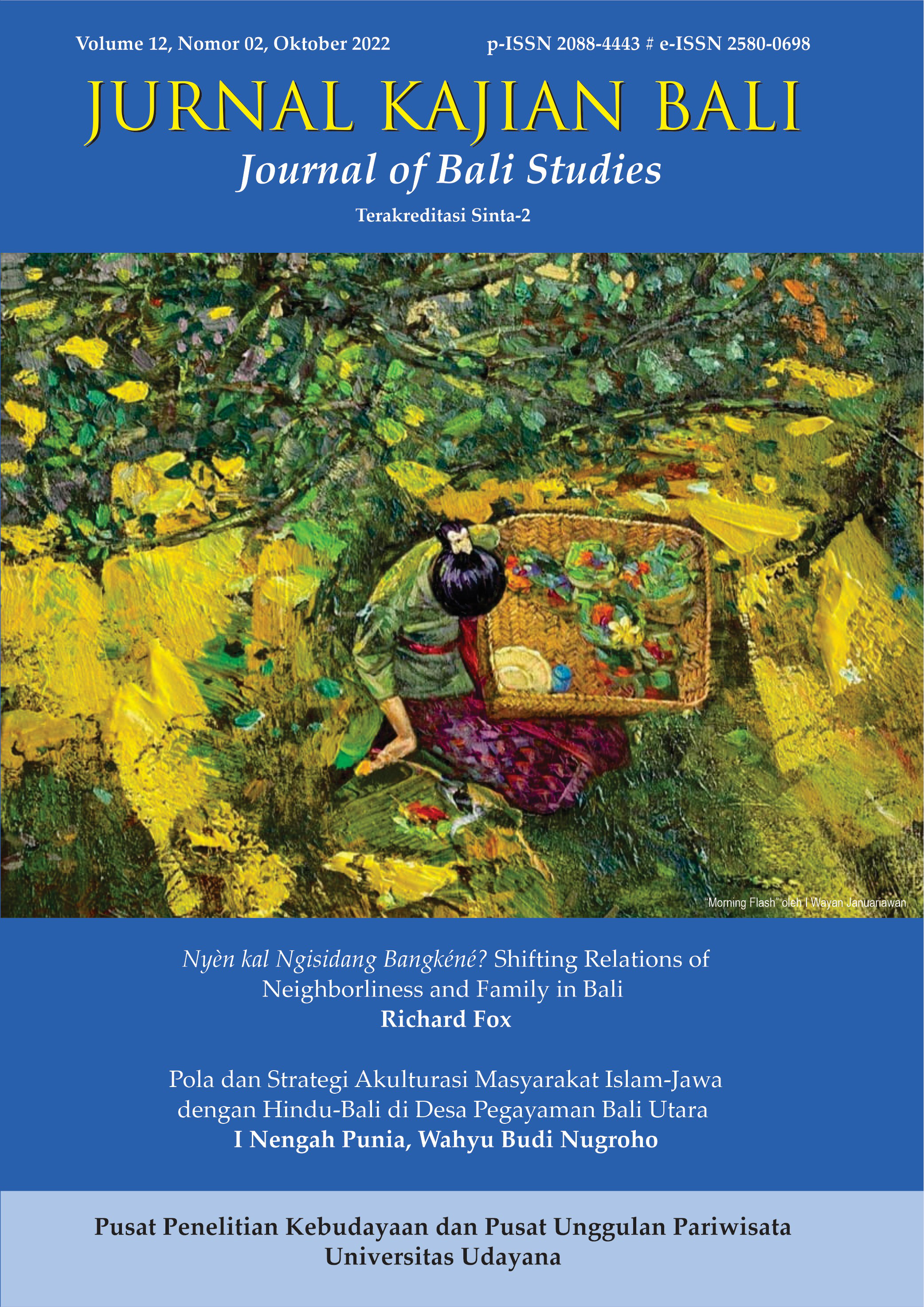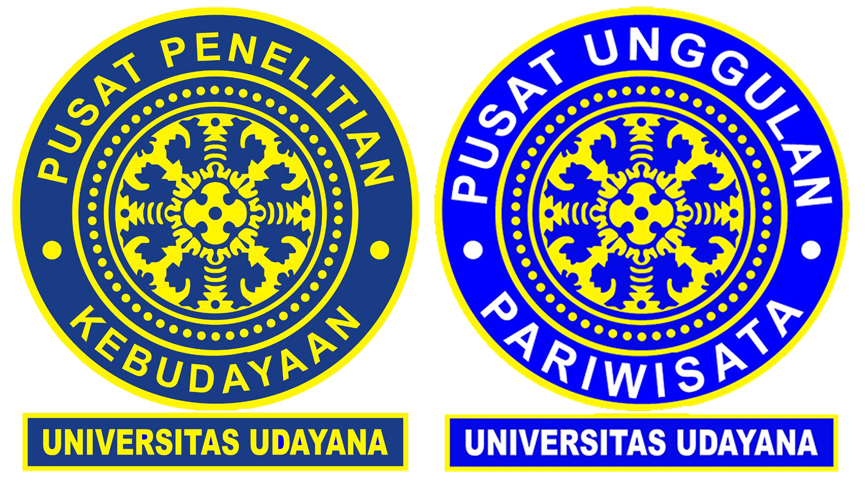Pola dan Strategi Akulturasi Masyarakat Islam-Jawa dengan Hindu-Bali di Desa Pegayaman Bali Utara
Abstract
This study aims to examine the patterns and acculturation strategies of Javanese-Islamic society to Hindu-Balinese in Pegayaman Village, Buleleng, North Bali. The history of the existence of this society in Pegayaman Village has been going on since the 16th century and continues to live side by side in harmony with the Hindu-Balinese society until now. The research method used in this study is a descriptive-explanative qualitative research method. The study found that the pattern and acculturation strategy of the Javanese-Islamic society in Pegayaman Village with the Balinese ethnic society is in the form of semi-assimilation and integration strategies. These pattern and acculturation strategies are manifested both in culture as a system of ideas, patterned activities, and artifacts or objects made by humans. This article is expected to provide recommendations for acculturation patterns and strategies for society in various regions considering the plural and multicultural condition of the Indonesians.
Downloads
References
Berry, J. W. (2005). Acculturation: Living Succesfully in Two Cultures. International Journal of Intercultural Relations. 29 (2005), pp. 679-712.
Geertz, C. (1964). The Religion of Java. London: Free Press of Glecoe.
Kartini, I. (2011). Dinamika Kehidupan Minoritas Muslim di Bali. Jurnal Masyarakat Indonesia, Vol. 31/No. 2, pp. 115-145.
Kewuel, H. K. et.al. (2017). Studi Kebudayaan I: Pluralisme, Multikulturalisme, dan Batas-Batas Toleransi. Malang: Prodi Antropologi, FIB, Universitas Brawijaya.
Mahadewi, I. G. A. M. et.al. (2020). Pengesahan Awig-Awig Desa Adat berdasarkan Peraturan Daerah Nomor 4 Tahun 2019. Jurnal Konstruksi Hukum. Vol. 1/No. 1. Pp. 187-191.
Napsiah. (2019). Modal Sosial sebagai Penguatan Identitas Sosial Masyarakat Muslim di Bali. Jurnal Studi Masyarakat, Religi, dan Tradisi. Vol. 5/No. 1, pp. 101-111.
Nusantara, T. B. (2020). Tradisi Mrangkat dalam Pernikahan Perspektif Urf’: Studi di Desa Pegayaman, Kecamatan Sukasada, Kabupaten Buleleng, Bali. Skripsi. Malang: Universitas Islam Negeri Maulana Malik Ibrahim.
Punia, I. N. & W. B. Nugroho. (2018). Nyepi di Kampung Muslim Al-Amin: Leksikon Dinamika Sosial Toleransi Beragama di Denpasar, Bali. Jurnal Kajian Bali. Vol. 8/No. 2. Pp. 159-180.
Ramadhan, R. B. (2017). Hadroh di Dusun Banyunganti Kidul: Studi Teori Fungsional Thomas F. O’dea. Jurnal Living Hadis. Vol. 2/ No. 1. Pp. 49-66.
Suarnaya, I. P. (2021). Model Moderasi Beragama Berbasis Kearifan Lokal di Desa Pegayaman, Kabupaten Buleleng. Jurnal Widya Sastra Pendidikan Hindu. Vol. 4/No. 1. Pp. 45-59.
Ritzer, G. [ed.]. (2007). The Blackwell Encyclopedia of Sociology. Oxford: Blackwell Publishing.
Pageh, I. M. et.al. (2013). Faktor Integratif Nyama Bali-Nyama Selam: Model Kerukunan Masyarakat pada Era Otonomi Daerah di Bali. Jurnal Kajian Bali. Vol. 3/No. 1. Pp. 191-206.
Setiawan, E. (2015). Nilai-Nilai Religius dalam Syair Shalawat Burdah. Jurnal Lingua. Vol. 10/No. 1. Pp. 1-8.
Soekanto, S. (2006). Sosiologi: Suatu Pengantar. Jakarta: Rajawali Pers.
Sumbulah, Ummi. 2012. Islam Jawa dan Akulturasi Budaya. Jurnal e-Harakah. Vol. 4/No. 1. Pp. 51-68.
Syahyuti. (2003). Alternatif Konsep Kelembagaan untuk Penajaman Operasionalisasi dalam Penelitian Sosiologi. Forum Penelitian Agro Ekonomi. Vol. 21/No. 2, Desember 2003, Pp. 113-127.
Umanailo, M. C. B. et.al. (2019). The Thought of Emile Durkheim In The Contestation of Development in Indonesia. International Journal of Scientific and Technology Research. Vol.8/I.08. Pp. 1881-1885.
Vargas-Ramos, C. (2011). Migration and Political Resocialization: The Impact of Political Environment Change on Political Orientations among Puerto Rican Return Migrants. Centro Journal. Vol. XXIII/No. 1. Pp. 125-161.
Wartayasa, I. K. (2018). Kebudayaan Bali dan Agama Hindu. Ganaya: Jurnal Ilmu Sosial dan Humaniora. Vol. 1/No. 2. Pp. 173-192.
Watzlawik, M. et.al. (2012). First Name as Signs of Personal Identity: An Intercultural Comparison. Journal Psychology in Society. Vol. 8, p. 1159-1176.
Weber, M. (2009). Sosiologi. Yogyakarta: Pustaka Pelajar.
Wirth, J. H. & E. D. Wesselman. (2018). Investigating How Ostracizing Other Affects One’s Self-concept. Journal of Self and Identity. Vol. 17/No. 4, May 2018, Pp. 369-406.
Zimmermann, J. (2021). Hermeunetika: Sebuah Pengantar Singkat. Yogyakarta: IRCiSoD.
Zulaeha, N. et.al. (2019). Perancangan Pengalokasian Dana Desa Berbasis Prinsip Syari’ah melalui Pembentukan Badan Usaha Milik Desa (BUMdes): Studi Kasus di Desa Pegayaman, Kecamatan Sukasada, Kabupaten Buleleng. Jurnal Ilmiah Mahasiswa Akuntansi Undiksha. Vol. 10/ No. 2. Pp. 124-135.

This work is licensed under a Creative Commons Attribution 4.0 International License.



















